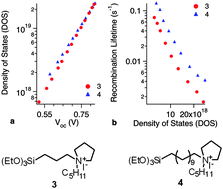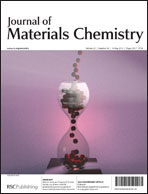This paper reports the synthesis and characterisation of a family of heterocyclic triethoxysilyl iodides of general formula, (EtO)3SiR2-N+R1, where R1 = –C5H11, –CH2C6H5 or –C16H33; N+ = pyrrolidinium or piperidinium; and R2 = –(CH2)3– and –(CH2)11– and their applications as organic iodide sources for use in dye sensitised solar cells. The effect of three variations in the structure of these derivatives (viz., R1, R2 and N+) on DSSC performance has been investigated using a range of techniques, including I–V profiling at different light intensities and transient photovoltage and photocurrent measurements. The results of these analyses have been used to develop an understanding of how different organic cations interact with the DSSC on a molecular level and influence the overall performance of the device. Of the three parameters, the length of the spacer – R2 – was found to have the greatest influence of device performance. Use of the organic iodides with the longer spacer – where R2 = –(CH2)11– were superior in performance to those with a shorter spacer – where R2 = (CH2)3– with devices constructed using the silyl iodide with longer spacer showing larger open circuit voltages and longer recombination times in comparison to those prepared using the shorter one.

You have access to this article
 Please wait while we load your content...
Something went wrong. Try again?
Please wait while we load your content...
Something went wrong. Try again?


 Please wait while we load your content...
Please wait while we load your content...